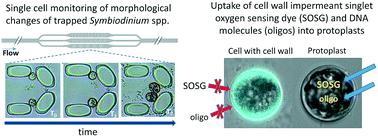Our official English website, www.x-mol.net, welcomes your feedback! (Note: you will need to create a separate account there.)
Viable protoplast formation of the coral endosymbiont alga Symbiodinium spp. in a microfluidics platform
Lab on a Chip ( IF 6.1 ) Pub Date : 2022-05-19 , DOI: 10.1039/d2lc00130f Faiza Bashir 1, 2 , Sándor Kovács 1 , Ágnes Ábrahám 3, 4 , Krisztina Nagy 3 , Ferhan Ayaydin 5 , Ildikó Valkony-Kelemen 5 , Györgyi Ferenc 1 , Péter Galajda 3 , Szilvia Z Tóth 1 , László Sass 1 , Péter B Kós 1, 6 , Imre Vass 1 , Milán Szabó 1, 7
Lab on a Chip ( IF 6.1 ) Pub Date : 2022-05-19 , DOI: 10.1039/d2lc00130f Faiza Bashir 1, 2 , Sándor Kovács 1 , Ágnes Ábrahám 3, 4 , Krisztina Nagy 3 , Ferhan Ayaydin 5 , Ildikó Valkony-Kelemen 5 , Györgyi Ferenc 1 , Péter Galajda 3 , Szilvia Z Tóth 1 , László Sass 1 , Péter B Kós 1, 6 , Imre Vass 1 , Milán Szabó 1, 7
Affiliation

|
Symbiodiniaceae is an important dinoflagellate family which lives in endosymbiosis with reef invertebrates, including coral polyps, making them central to the holobiont. With coral reefs currently under extreme threat from climate change, there is a pressing need to improve our understanding on the stress tolerance and stress avoidance mechanisms of Symbiodinium spp. Reactive oxygen species (ROS) such as singlet oxygen are central players in mediating various stress responses; however, the detection of ROS using specific dyes is still far from definitive in intact Symbiodinium cells due to the hindrance of uptake of certain fluorescent dyes because of the presence of the cell wall. Protoplast technology provides a promising platform for studying oxidative stress with the main advantage of removed cell wall, however the preparation of viable protoplasts remains a significant challenge. Previous studies have successfully applied cellulose-based protoplast preparation in Symbiodiniaceae; however, the protoplast formation and regeneration process was found to be suboptimal. Here, we present a microfluidics-based platform which allowed protoplast isolation from individually trapped Symbiodinium cells, by using a precisely adjusted flow of cell wall digestion enzymes (cellulase and macerozyme). Trapped single cells exhibited characteristic changes in their morphology, cessation of cell division and a slight decrease in photosynthetic activity during protoplast formation. Following digestion and transfer to regeneration medium, protoplasts remained photosynthetically active, regrew cell walls, regained motility, and entered exponential growth. Elevated flow rates in the microfluidic chambers resulted in somewhat faster protoplast formation; however, cell wall digestion at higher flow rates partially compromised photosynthetic activity. Physiologically competent protoplasts prepared from trapped cells in microfluidic chambers allowed for the first time the visualization of the intracellular localization of singlet oxygen (using Singlet Oxygen Sensor Green dye) in Symbiodiniaceae, potentially opening new avenues for studying oxidative stress.
中文翻译:

珊瑚内共生藻的可行原生质体形成 Symbiodinium spp。在微流体平台中
共生藻科是一个重要的甲藻科,它与珊瑚虫等珊瑚礁无脊椎动物共生,使它们成为全息生物的中心。由于珊瑚礁目前受到气候变化的极端威胁,迫切需要提高我们对共生藻的压力耐受和压力避免机制的理解。活性氧(ROS)如单线态氧是介导各种压力反应的核心参与者;然而,在完整的共生藻中使用特定染料检测 ROS 仍远未确定。由于细胞壁的存在,某些荧光染料的吸收受到阻碍。原生质体技术为研究氧化应激提供了一个有前景的平台,其主要优点是去除细胞壁,但制备可行的原生质体仍然是一个重大挑战。以往的研究已经成功地将纤维素基原生质体制剂应用于共生藻科;然而,发现原生质体的形成和再生过程并不理想。在这里,我们提出了一个基于微流体的平台,该平台允许从单独捕获的共生藻中分离原生质体细胞,通过使用精确调整的细胞壁消化酶(纤维素酶和 macerozyme)流动。被捕获的单细胞在其形态、细胞分裂停止和原生质体形成过程中光合活性略有下降表现出特征性变化。在消化并转移到再生培养基后,原生质体保持光合作用活性,重新长出细胞壁,重新获得运动能力,并进入指数生长。微流体室中流速的提高导致原生质体形成速度更快;然而,较高流速下的细胞壁消化部分损害了光合活性。
更新日期:2022-05-19
中文翻译:

珊瑚内共生藻的可行原生质体形成 Symbiodinium spp。在微流体平台中
共生藻科是一个重要的甲藻科,它与珊瑚虫等珊瑚礁无脊椎动物共生,使它们成为全息生物的中心。由于珊瑚礁目前受到气候变化的极端威胁,迫切需要提高我们对共生藻的压力耐受和压力避免机制的理解。活性氧(ROS)如单线态氧是介导各种压力反应的核心参与者;然而,在完整的共生藻中使用特定染料检测 ROS 仍远未确定。由于细胞壁的存在,某些荧光染料的吸收受到阻碍。原生质体技术为研究氧化应激提供了一个有前景的平台,其主要优点是去除细胞壁,但制备可行的原生质体仍然是一个重大挑战。以往的研究已经成功地将纤维素基原生质体制剂应用于共生藻科;然而,发现原生质体的形成和再生过程并不理想。在这里,我们提出了一个基于微流体的平台,该平台允许从单独捕获的共生藻中分离原生质体细胞,通过使用精确调整的细胞壁消化酶(纤维素酶和 macerozyme)流动。被捕获的单细胞在其形态、细胞分裂停止和原生质体形成过程中光合活性略有下降表现出特征性变化。在消化并转移到再生培养基后,原生质体保持光合作用活性,重新长出细胞壁,重新获得运动能力,并进入指数生长。微流体室中流速的提高导致原生质体形成速度更快;然而,较高流速下的细胞壁消化部分损害了光合活性。


























 京公网安备 11010802027423号
京公网安备 11010802027423号